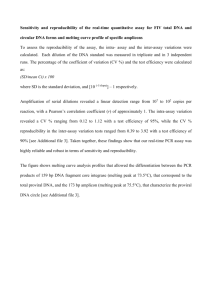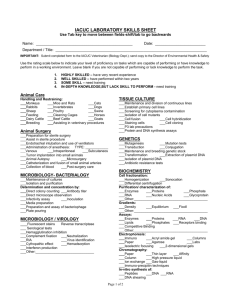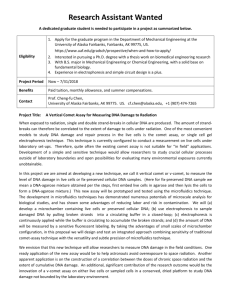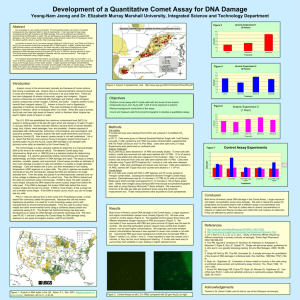The Effects of Arsenic Toxicity in PLHC-1 Cell Line
advertisement
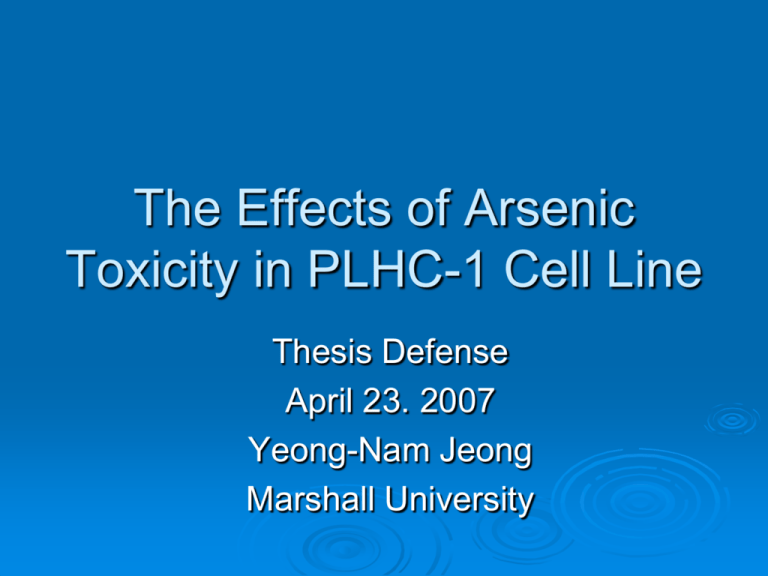
The Effects of Arsenic Toxicity in PLHC-1 Cell Line Thesis Defense April 23. 2007 Yeong-Nam Jeong Marshall University History of Arsenic Used over 2,400 years for medical purposes In the 18th century: used therapeutically Fowler’s solution: 1% arsenic trioxide in potassium bicarbonate, major therapy for leukemia treatment In the 19th century: materia medica In the 1970s: Chinese researcher studied as a treatment for acute promyelocytic leukemia (APL) Arsenic Two main categories of compounds Organic Inorganic Organic arsenic compounds are combined with Hydrogen and Carbon Inorganic arsenic compounds contain Oxygen, Chlorine, and Sulfur. Inorganic arsenic is more harmful than organic arsenic. http://www.uky.edu/WaterResources/SYMP01-ITAC.HTML Arsenic is Toxic Arsenic has been linked to several forms of cancer Arsenic is associated with heart, lung, immunological, nerve and hormone problems. Inorganic arsenic has both acute and chronic toxic effects. How arsenic causes cancer is not well understood. Apoptosis may be involved. http://www.epa.gov/watersecurity/guide/chemicalsensorforarsenic.html PLHC-1 Cell lines Poeciliopsis lucida hepatocellular carcinoma Derived from a liver tumor from topminnow Used to screen heavy metals and other environmental toxins using a combined stress protein and cytotoxicity assay. Comet Assay – DNA Damage DNA fragmentation assay Monitor apoptosis using PLHC-1 cells induced by As2O3 and Cadmium Chloride Apoptosis Nuclear chromatin condensation Shrinkage of cells Disintegration of nuclear membrane Break down of plasma membrane and formation of membrane-bound broken down cells (apoptotic bodies) Degraded nuclear DNA into ‘DNA ladder’ (Wyllie, 1981). This picture shows that arsenite-treated TO-2 cell line has no DNA ladder and arsenite-treated JF cell line detect apoptosis (Wang et al. 2004). Materials and Methods Cells were grown in T-75 cm2 flasks at 30oC CO2 Incubator in Minimum essential medium (Eagle) with 2 mM L-glutamine and Earle's BSS adjusted to contain 1.5 g/L sodium bicarbonate, 0.1 mM non-essential amino acids, and 1.0 mM sodium pyruvate, 95%; fetal bovine serum, 5% and 1% penicillin streptomycin. Cadmium Chloride 0.1M solution 1, 2 and 10 mM was prepared for comet Results: Cell Growth Assay I Results: Cell Growth Assay II Results: Cell Growth Assay III Materials – Arsenic (V) oxide, 99.9% (metal basis), Packed Under Argon. Stock #14668, Lot #L06M05. Alfa Aesar As2O3 – Arsenic (III) oxide, 99.9% (metal basis), Packed Under Argon. Stock #40370, Lot #M19I12. Alfa Aesar As2O5 Experimental Concentrations As2O3 As2O5 Cadmium Chloride 1 mM 1 mM 1 mM 5 mM 5 mM 2 mM 10 mM 10 mM 10 mM Arsenic Type Day Time of Exposure hours Treated Wells As2O3 1 1 1 As2O3 1 1 2 As2O3 1 2 1 As2O3 1 2 2 As2O3 2 1 1 As2O3 2 1 2 As2O3 2 2 1 As2O3 2 2 2 As2O5 1 1 1 As2O5 1 1 2 As2O5 1 2 1 As2O5 1 2 2 As2O5 2 1 1 As2O5 2 1 2 As2O5 2 2 1 As2O5 2 2 2 Categorical Scoring Categorical Data is Significant Comet Assay IV Software Two close cells were not good to measure. An example of a round, undamaged cells An example with medium damaged cells An example with high damaged cells Head Length Mean Graph with As2O3 concentration 21.5 21.0 20.5 20.0 19.5 19.0 TIME Mean HL 18.5 18.0 1.00 17.5 2.00 .00 AS2O3CON 1.00 5.00 10.00 Tail Length Mean Graph with As2O3 concentration 40 30 20 Mean TL TIME 1.00 10 2.00 .00 AS2O3CON 1.00 5.00 10.00 Head Intensity Mean Graph with As2O3 concentration 90 80 70 Mean HI TIME 1.00 60 2.00 .00 AS2O3CON 1.00 5.00 10.00 Tail Intensity Mean Graph with As2O3 concentration 30 20 Mean TI TIME 1.00 10 2.00 .00 AS2O3CON 1.00 5.00 10.00 Tail Moment Mean Graph with As2O3 concentration 8 7 6 5 4 Mean TM 3 TIME 2 1.00 1 2.00 .00 AS2O3CON 1.00 5.00 10.00 Tail Moment Mean Graph with As2O5 concentration 8 7 6 5 4 Mean TM TIME 3 1.00 2 2.00 .00 AS2O5CON 1.00 5.00 10.00 Why Does DNA Laddering Occur? http://www.sgul.ac.uk/depts/immunology/~dash/apoptosis/nuclear.html DNA Laddering Assay As2O3 Cadmium Chloride Normal appearance of cultured PHLC-1 cells The FragELTM DNA fragmentation Detection Kit, Fluorescent TdT Enzyme from CalBiochem Enzymatic addition of labeled nucleotides was carried out by using Terminal Deoxynucleotidyl Transferase (TdT) and fluorescein labeled deoxynucleotides. The Bio-Rad MRC1024 Confocal Scanning Microscope No arsenic treatment control cells. 5mM As2O3 1hr 5mM As2O3 3hr Future Directions Comet Assay: Controls have background problems and it could be trypsin or cell growth pattern. DNA ladder assay: PLHC-1 may have different pathway MTT assay: I am repeating this assay for my class, if it works I will add to the thesis. Western blot: I am repeating this assay for my class, if it works I will add to the thesis. Other experiments: DAPI, HSP-70, Caspase, TUNEL assay etc.. Conclusions PLHC-1 cells can be useful for comet assay As2O3 causes DNA damages in PLHC-1 cells a dose dependent fashion. 1 hour had better data in comet assay than 2 hours because cells were more damaged after 2 hours. As2O5 also cause DNA damage but it was less consistent than As2O3 Conclusions As2O3 did not cause DNA laddering in PLHC-1 cells. Camptothecin and Cadmium also did not cause DNA laddering in PLHC-1 cells. Wang et al. shows that some fish cells do not have DNA laddering during apoptosis. The FragELTM DNA fragmentation Detection Kit Assay was positive for apoptosis DNA damages with PLHC-1 cell in As2O3 treatment. Acknowledgements Dr. Collier for using Olympus BX51 microscope and photomicrographs were take at using Olympus Microsuite™ Basic software. Mr. David Neff for using Confocal Microscope and The FragELTM DNA fragmentation Detection Kit Assay . Dr. Cohenford for fluorimeter. Mr. Pete Glass and Dr. Little for GIS class. Dr. Harrison for using hemocytometer. IST 343 student for help with MTT assay. Ms. Wanda Dyke for help with all ordering, receiving, PAR and so on. Dr. Murray and Committee for reading, writing and presentation help. Thanks to My family for sending me to US, especially Jooha Jeong. Thank you… References 1. 2. 3. 4. 5. 6. 7. 8. 9. 10. 11. 12. 13. 14. 15. 16. Samuel Waxman, Kenneth C. Anderson. History of the Development of Arsenic Derivatives in Cancer Therapy. Oncologist. 2001; 6: 3-10 http://www.uky.edu/WaterResources/SYMP01-ITAC.HTML http://www.wise-uranium.org/mdafin.html http://www.epa.gov/watersecurity/guide/chemicalsensorforarsenic.html Jin Y, Sun G, Li X, Li G, Lu C, Qu L. Study on the toxic effects induced by different arsenicals in primary cultured rat astroglia. Toxicol Appl Pharmacol. 2004; 196:396-403. Tice RR, Agurell E, Anderson D, Burlinson B, Hartmann A, Kobayashi H, Miyamae Y, Rojas E, Ryu JC, Sasaki YF. Single cell gel/comet assay: guidelines for in vitro and in vivo genetic toxicology testing. Environ Mol Mutagen. 2000; 35:206-21. C. Risso-de Faverney, A. Devaux, M. Lafaurie, J.P Girard. B. Bailly, R. Rahmani. Cadmium induces apoptosis and genotoxicity in rainbow trout hepatocytes through generation of reactive oxygene species. Aquatic Toxicology. 2001; 53: 65-76 Singh NP, McCoy MT, Tice RR, Schneider EL. A simple technique for quantitation of low levels of DNA damage in individual cells. Exp Cell Res. 1988 Mar; 175(1):184-91. Ryan JA, Hightower LE. Evaluation of heavy-metal ion toxicity in fish cells using a combined stress protein and cytotoxicity assay. Environ. Tox. Chem 1994; 13: 1231-1240. Krone PH, Blechinger SR, Evans TG, Ryan JA, Noonan EJ, Hightower LE. Use of fish liver PLHC-1 cells and zebrafish embryos in cytotoxicity assays. Methods. 2005; 35:176-87. www.nativefish.org/Gallery Xin-Mei Liu, Jian-Zhong Shao, Li-Xin Xian, Xian-Yong Chen. Cytotoxic Effect and Apoptosis Induction of Atrazine in a Grass Carp (Ctenopharyngodon idellus) Cell Line. WILEY InterScience. 2006. 80-89. Zigang D. The Molecular Mechanisms of Arsenic-Induced Cell Transformation and Apoptosis. Environmental Health Perspectives. 2002; 110(5): 757-759. Yu-Chieh Wang, Ren-Haw Chaung, Li-Chu Tung. Comparison of the cytotoxicity induced by different exposure to sodium arsenite in two fish cell lines. Aquatic Toxicology. 2004; 69: 67-79 M Rau Embry, SM Billiard, RT Di Giulio. Lack of p53 induction in fish cells by model chemotherapeutics. Oncogene. 2006; 25: 2004-2010. R. Ian Freshney. Culture of Animal Cells. A Manual of Basic Technique. 4 th Edition. Wiley-Liss
